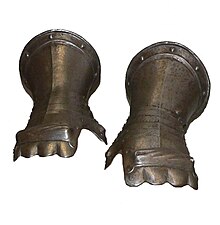Gauntlet
Gauntlets (also:. English Gauntlet , Gauntlet, iron glove) were elements of medieval armor . They were used to protect the hands and often the forearms and were made of different materials. Different names were used for the various stages of development.
description
The first gauntlets were made of simple, thick leather . These gloves had a cuff about 5 cm wide and were worn until about the beginning of the 13th century. From around the time the Haubert came into use, mittens were used with the backs of the hands sewn with metal rings. With these gloves, only the thumb was freely movable in order to be able to grasp the weapons correctly. Around the 13th century, an improved version appeared in France called "Gagnepain" (French for "canepin", "tanned skin"). The Gagnepain was a thick leather glove with metal plates attached to the back.
The experiences from the 5th Crusade caused a rethink in armaments production. The mittens were no longer used and gauntlets made of the stronger fallow deer leather were chosen . In the battle , additional pieces of thick cowhide were tied on the back of the hand up to the elbow . From the 14th century onwards , metal plates worked in the shape of a thumb were attached to the leather. The back of the hand was secured with a round metal disk.
The first metal gauntlets were made around 1450. The back of the hand was protected by a metal plate to which a short piece of metal was attached with a hinge that protected the thumb. Around the same time, the first type of gauntlet was developed that protected the entire top of the hand and finger. The so-called Hentze protected the back of the hand and the wrist. The metal plate that protected the top of the hand ended in a cuff that reached over the wrist. The fingers and thumb were protected by plates that were attached to each other like scales (shifted). A leather glove was worn under the hat. The Hentzen were often equipped with a stem disc on the back of the hand, about the level of the wrist. They were used either as an abutment or as a fastening for the reins when using the sword in a mounted attack. It was at this time that the first finger gloves were made, partly a mixture of chain mesh and metal plates (brigandine glove).
In the 16th century , the finger gloves came more and more into use and the Hentzen slowly disappeared. The fingers of the gauntlets, as well as the cover plate of the back of the hand, were made of several smaller metal plates that allowed greater freedom of movement. In Italy there was a hybrid form in which chain mesh was combined with plate armor (pikeman glove). These gloves were used by the pikemen. Another version of the gloves used by the pikemen has a gauntlet that reached to the elbow.
In Italy a version was created that was known as "combat gloves". The palm of these gauntlets was also protected by sliding metal plates. Sharp iron spikes were attached to the ends of the index and little fingers and the thumb. These gloves were also useful after losing your main weapon or in hand-to-hand combat to hit the face or unprotected parts of the body. They generally didn't catch on.
The gauntlets emerged in these types almost exclusively in Europe. In other countries, gloves made of chain mesh or other, lighter materials were preferred.
See also
Web links
- Early gauntlet, reconstruction of a gauntlet in the 14th century, with references to sources
- Gauntlet, 16th century original, probably from Milan , approx. 1585.
literature
- Wendelin Boeheim : Handbook of the armory. The weapon system in its historical development from the beginning of the Middle Ages to the end of the 18th century (= Seemanns Kunstgewerbliche Handbücher. Vol. 7, ZDB -ID 53757-3 ). Seemann, Leipzig 1890, pp. 78-86 (reprint. Fourier Verlag, Wiesbaden 1985, ISBN 3-201-00257-7 ).
- George Cameron Stone : A Glossary of the Construction, Decoration and Use of Arms and Armor in All Countries and in All Times. With an Introduction by Donald J. LaRocca. Courier Dover Publications, Mineola NY 1999, ISBN 0-486-40726-8 , pp. 244-246.







